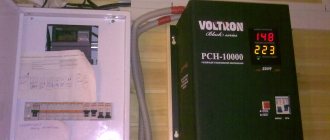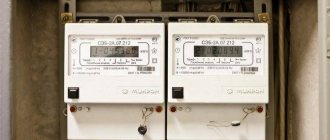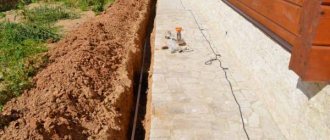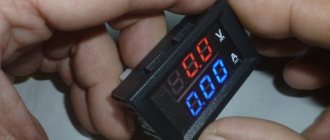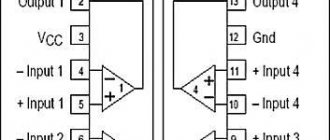When building a house in the private sector, the home builder is faced with the question of what voltage to supply to it. For household appliances, 220 V is sufficient, but installation of various machines is also possible. In addition, if the house is large enough, the load on the phase will also be large. In this case, a rational solution would be to connect to a 380 volt network. This will allow you to divide the power supply groups of household appliances into lines or connect equipment that requires a higher voltage than in the household network.
Features of three-phase: differences from the usual 220 V
Unlike a conventional two-wire system, a 380-volt connection requires the use of a four-conductor cable, not counting the ground, which is mounted separately. In this case, 3 wires will be phase, and one will be zero (neutral). Many people do not understand how 220 and 380 V are connected, believing that different generators are used to generate them. In fact, everything is much simpler. Any three-phase system can be divided into 3 lines with a common household voltage. Using one of the phases and a neutral wire, 220 V is obtained.
Helpful advice! If you need to briefly connect equipment operating from a 380V network in an apartment building, you can get power from the distribution board on the staircase - each of them has 3 phases. However, it is worth remembering that such actions will be regarded by utility services as theft of electricity, and such switching is impossible through a household meter.
It is quite possible to formalize a 380V connection in an apartment, but only if there is no gas main connected to the house. In this case, when installing an electric stove operating on three-phase current, it is necessary to complete the necessary documentation. However, this is not a matter of one day, and much depends on whether such an opportunity exists in principle.
SNT Vinogradovo portal
When connecting a plot of land or a house to electrical networks, the question often arises: what voltage is needed: 220 or 380 volts? Can I get by with “regular” electricity or do I need “three phases”? From the transformer substation to the sections in SNT there are power lines with a voltage of 0.4 kilovolts (kV). This group includes voltage networks of 220 V (0.22 kV) and 380 V (0.38 kV). 380 V is supplied to the network from the transformer substation, i.e. three phases. It looks like four wires. Three of them are the same phases, and one is the so-called “neutral”, or “zero”. If we measure the voltage between any two “phases,” we get 380 V, and if between any of the “phases” and “zero,” then 220 V.Typically, for 380 V lines, self-supporting insulated wire (SIP) is used, where all four cores are covered with insulating material. There are 380 V lines with four separate non-insulated aluminum wires.
If there is a three-phase line running down the street, then from any pole you can connect 380 V or 220 V to the house. In the first case, all four wires are supplied to the consumer, in the second - only two, one of the “phases” and “zero”.
It is more difficult if there are only two wires running along the poles - zero and “phase”. For example, from the transformer the three available phases were distributed, one to each street. This is how a situation arose when a line with two wires, “phase” and “zero”, goes past the site. Such lines are still found in SNT, ONT, DNT. Therefore, in this case, connecting 380 V is impossible, because it is necessary to change the cable along the entire length from the transformer substation to the site.
Are “three phases” needed in a house on a plot in SNT? Let's consider which devices require 380 V: electric heating boiler with a power above 9 kW; deep pump for artesian well; electric sauna stove with a power above 5 kW; semi-professional equipment - lathe or milling machine, high-power circular saw; electric motors. If the installation of these devices is not planned, then 380 V is not needed. By the way, all of the above equipment is available in the 220 V version.
If you choose three phases based on considerations that might come in handy in the future, then you need to know that the power supplied to the house should be divided evenly between the three phases. If one of the phases is overloaded relative to the others, a phenomenon called “phase imbalance” occurs. If one of the phases is overloaded, the machine will “knock out” and the electricity will be turned off. The consequence may be failure of electrical appliances.
In a modern home, 380V is not necessary. Additionally, at 380V there is an increased risk of electrical shock and fire hazard due to the higher voltage. For ordinary household needs, a 220 V network is used. At the same time, there is less wear on wires and contacts and higher electrical safety at home.
Source: https://energovopros.ru/issledovania/2322/2330/50180/
Advantages of a three-phase system in the private sector
Rural areas experience frequent power outages. It is not the energy sales companies that are to blame here, but the deterioration of transformer substations and the low level of qualifications of the electricians serving the area. Most often, the problem is phase imbalance, caused by too much load on one of them with minimal load on the other. In this case, when 380 volts are introduced into the house, the home master can independently check the voltage on each of the lines and decide which of them can be used to power household appliances.
Another advantage is cost-effectiveness. Three-phase users typically have lower electricity bills. But it is worth remembering that in addition to the more complex connection of 380 volts, certain documentation will be required. You will have to run around a bit through the authorities before permission is obtained.
How to connect a 380 volt line
When connecting a house, the design power consumption is calculated. The fact is that when connected, the energy supply organization allocates a limited amount of power. For example, 3 kW with 220 V and 3 kW with 380 V, which are taken from the nearest support. Everything above is connected directly from the nearest transformer. The cables from the transformer to your home are usually laid at the expense of the customer, that is, you pay.
If you need 380 V in your home and household, you must stretch a line or lay a cable on the ground. Section calculations, design and laying are carried out by specialized companies. You just pay for all the work. This means that you must carefully prepare a list of possible equipment that requires a 380 V connection. This will minimize your costs in the future.
Every woman on this planet knows what menstruation is and how many difficulties arise in order to protect underwear and clothes from menstrual blood. What the ladies didn’t come up with “these days” to maintain cleanliness. To help them, gaskets were invented, which have gone through a long path of renovation in order to become a women's lifesaver these days.
Registration of permits for connection
First, you need to prepare a project that will specify equipment that requires a higher voltage than in a regular home network. Based on the characteristics of the equipment planned for connection, the management company draws up technical specifications that specify cable cross-sections, grounding parameters and other mandatory data. After this, an act is drawn up, which includes reports from employees who checked the equipment and confirm the need to supply 380 volt power to the house.
But there are exceptions to these rules. If the distance from a private house to the nearest three-phase power line is more than 500 m, then connecting high voltage is impossible - no one will give such permission, even if the owner independently installs additional poles. In this case, if such power is necessary, the only option is to install a 380-volt generator running on diesel fuel or gasoline.
Connection of three-phase voltage 380 volts.
When talking about high voltage, most people mean 220 volts.
This is fully sufficient for the normal functioning of household appliances (washing machine, dishwasher, refrigerator, microwave oven, toaster, etc.). To connect three-phase voltage, a factor such as a lack of electricity due to improper distribution in the network is necessary. Connecting or reconnecting three-phase voltage is necessary for the operation of powerful 380-volt equipment. First of all, in order to have 380 volts in the house, you need to replace the power cable. If you had a 220-volt cable installed, then it certainly won’t work, since it contains three wire strands; for a voltage of 380 volts, four strands are needed. Just replace the cable. Ideally, it should not be twisted, soldered, or the like; a single cable is needed from start to finish.
The most difficult and costly thing after obtaining permission will be purchasing components and assembling a 380-volt electrical panel. Its assembly is carried out strictly in accordance with the instructions received from the energy supply company, otherwise the shield will not pass the test and 380 volts will not be connected to it.
This is the official electrical panel wiring diagram. The circuit starts from the power pole and goes to the electrical panel.
The following is drawn in the square of the input and metering panel: Grounding connection diagram. It is sealed and connected to zero before the meter. 25 amp circuit breakers are sealed. After them, a 380 V electric meter is connected. Afterwards, machines are installed at the output to which the wiring of the house, bathhouse, garage, etc. is connected.
Connection diagram for an electrical panel with a 380 volt meter:
it is recommended to check the absence of a phase on the case, then measure the voltage at the starter or terminal block in the device itself, between the phases there are 380 Volts - this means you have connected everything correctly. Follow all safety rules.
To connect, you must perform the following steps:
- Turn off the voltage and, if possible, check with an indicator screwdriver.
- Connect 3 opposite phases A, B and C to contacts L1, L2, L3 in any order. The phase order only affects the direction of rotation of the electric motor. To change the rotation of the motor in the other direction, it will be necessary to swap only any 2 phases on the contacts of the magnetic starter or machine.
- A zero is connected to pin N.
- A protective grounding conductor from the grounding loop is connected to the PE contact, or marked with a special symbol, as in the picture on the right.
The main types of sockets for connecting 380 volts
All these types of sockets are domestically produced. Their functional capabilities are no worse than their foreign counterparts and are several times cheaper. There is one point in installing external sockets, this is their aesthetic appearance. Basically, they are installed in houses with European-quality renovation, so as not to spoil the overall appearance. When purchasing such sockets, it is necessary to take into account the plugs (plugs), because the equipment may have different plugs installed depending on the manufacturer of the equipment. But don’t despair, because if necessary, the plug can be replaced with the one you need.
There are no difficulties when connecting a three-phase outlet; almost anyone can do it; you just have to follow the instructions.
From the legislation of the Republic of Belarus.
All work on the electrification of a residential building performed by an organization or entrepreneur that does not have a “Certificate of Technical Competence” is not allowed to be used. A copy of this document must be attached to the contract.
According to TKP 45-1.01-221-2010, the permit for electrical installation work is the “Certificate of Technical Competence”. The certificate indicates the types of work that the organization or entrepreneur is allowed to perform. The specified certificate is issued if there are specially trained personnel on staff with the appropriate education, the necessary experience in performing electrical installation work, who have passed the knowledge test of the Electrical and Fire Safety Rules.
Reasons for the need to connect 380 V
If you only plan to divide a three-phase line into three single-phase ones and use it only for lighting and powering household appliances, there is no point in completing the documentation. In addition, employees of the management company inspecting the equipment will not give permission for such a connection. It’s another matter if the owner has a small workshop in one of the buildings. The same circular saw, which is driven by a 380-volt electric motor, can become the reason for connecting a three-phase line. And how the owner will make further connections after the electricity meter is no one’s business.
The home network, as serviced by the management company, can be compared to a water supply network. Everything that is connected to the meter is the property of public utilities and is serviced by them. Communications located after the metering device, i.e. on the owner’s side, belong to the owner of the premises. He is responsible for their condition.
High voltage application
The most popular in the private sector are small tire fitting points, which are quite simple to equip, provided you have a certain initial capital - country roads in such areas require periodic damage to car wheels. In this case, a single-phase line is not enough. Here you will need to connect various machines, a 380 volt compressor and other devices. The only thing that should be taken into account is the same possible phase imbalance. To protect electrical equipment, it is worth purchasing and installing a voltage relay or stabilizing device. This will increase the life of 380 volt motors, which are used in almost all tire changing equipment.
Quite often, high voltage is required in the house itself. Some models of kitchen stoves are not capable of operating on 220V. A similar situation can occur in an apartment building, some of which, due to fire hazard or dilapidation, are not equipped with gas appliances. If you purchased such a stove, the procedure for connecting 380 volts will be identical to that described above.
Connecting a three-phase power outlet
Before connecting 380 volts, you will need to make some calculations. It is necessary to select the correct wire cross-section and material of its manufacture. Calculations are made based on the power consumption of the equipment. The first thing you need to do is write down the data of the household appliance, which can be found on the nameplate or in the technical documentation. The calculation formula will look like this – I= P/(√3×U×cos(φ)), where:
- I – current. It is based on this parameter that conclusions will be drawn regarding the cross-section of the wire;
- U – voltage of one phase. In the case of a three-phase household system, this parameter is 220 V;
- cos(φ) – phase shift angle indicator. It is also marked on the nameplate;
- P – power consumption of an electric stove or other equipment.
Having calculated the current, you need to decide on the cable material (using copper wire would be more rational), after which you should use the cross-section table. Such information is easy to find on the Internet, and therefore there is no point in dwelling on it in detail.
Connecting a 380 volt outlet does not present any difficulties. All contacts of such products are marked, which means it is almost impossible to make a mistake during installation. The main thing is that the outlet should not be located closer than 60 cm from the water tap, so that moisture cannot get on it.
What is a three-phase network?
Before putting into operation, any house or apartment is connected to the local power grid. Such a network can be single-phase or three-phase. With a single-phase connection, two wires are supplied to the house, a phase and a zero, between which the voltage is 220 V. A three-phase network is characterized by the presence of four wires: three phases and a zero. Between each phase and zero the voltage is 220 V, and between the phases themselves 380 V (as shown in the image).
To account for electricity in such a network, a three-phase meter is required, which is installed by the local distribution zone. A typical example of such a meter is INCOTEX Mercury 231 AM-01, designed for metering active electricity.
Connecting three-phase power in the distribution cabinet
After 380 V is connected to the switchboard, correct switching should be performed. Input is made through a powerful machine or feeder switch. After it, an electricity meter is connected, the power from which goes to the protective automation of the home network. It looks like this (elements may vary depending on the wishes of the owner):
- A general circuit breaker that can withstand the load consumed by all electrical appliances at home.
- Three AVs of lower rated power, by group. This could be the kitchen, other sockets in the house, or a lighting group.
- 3 residual current devices, from which power is distributed separately to rooms.
Let's analyze the visual diagram in detail
The apartment's power supply is three-phase 380 Volt. The electrical wiring is planned to be five-wire with three phase working conductors (L1; L2; L3), a neutral working conductor (N) and a protective conductor (PE).
A three-phase input circuit breaker (8) is installed at the power supply input. It disconnects three working phase conductors from the external power supply.
The neutral working conductor is connected directly to the electric meter (9). The electric meter (9) is three-phase.
The electrical wiring of an apartment or house is protected by a general circuit breaker (6). The general circuit breaker is 4 (four) contact. It protects the electrical wiring of the apartment from short circuit current and network reboot. Also, using a circuit breaker, you can forcibly disconnect all electrical wiring of an apartment or house from the power supply in order to carry out technical work.
In the electrical panel (1), the electrical wiring is divided into separate power supply groups. The division into groups occurs on three switching buses (2). Phase wires from a common circuit breaker are connected to these three separate buses. The buses are called phase. The zero working conductor is connected to the zero working bus (2 A). A separate bus called the ground bus (2B) is intended for connecting protective conductors.
This is the same. Format: 752×726 pixels.
Note: When completing an electrical panel, it is better to purchase tires made in protective housings. In general, switching bars, sometimes called blocks, are manufactured in protective dielectric (non-conducting electricity) cases and are open. Since the electrical panel in question should be installed in a residential area to protect against accidental contact with the live busbars, it is better to use the busbars in a protective casing.
One more thing. In a visual diagram of the electrical panel, the contact bars of the phase (2) and neutral (2A) conductors are shown together. During actual installation, it is better to space these tires across the panel. Install the phase busbars at the top of the electrical panel housing, the zero operating busbar and the grounding busbar on the right and left or at the bottom of the electrical panel housing. Read the article: Installing a distribution board.
Power supply, household appliances and equipment of an apartment or house (7) is divided into groups. The electrical wiring of each group is protected by a common group differential circuit breaker (4). The differential circuit breaker is a circuit breaker and an RCD (residual current device) in one housing.
Important! Electrical wiring for a three-phase power supply should be evenly distributed across the three phases. Each phase must power electrical equipment with the same total power. Uneven distribution or phase imbalance will lead to failure of household electrical appliances, and possibly to emergency situations. Which, of course, is unacceptable.
From general group differential circuit breakers, each electrical circuit of the group is protected by single-pole circuit breakers (5). The exception is a separate dedicated group for powering the electric stove (3). For the electric stove, the circuit breaker protects two plus (phase, zero).
All electrical wiring must be carried out using a three-wire electrical cable with a third protective, grounding conductor. Each socket in the room has a grounding contact, and even the lighting of the room is planned with protective grounding of the housings. In our opinion, PUE (electrical installation rules) is of course unnecessary, but this scheme fully complies with IEC (International Electrotechnical Commission) standards. However, you need to remember that the power supply is carried out according to the TN circuit, with a solidly grounded neutral of the substation transformer.
Everything about this Scheme of an apartment electrical panel with a 380 Volt power supply and a protective conductor. ©Elesant.ru
Phase voltage: more dangerous or not?
The consequences are the same as with linear, but in more severe forms with less time of exposure to current on the human body. The voltage between two phases is fraught with other, even more terrible consequences, which can be caused by an arc. This phenomenon does not require direct contact with a conductor or other live part. It is enough to be dangerously close to them. The arc tears out part of a person's skin and muscle with accompanying lesions inherent in a normal electric shock.
Some safety standards for servicing a three-phase network
Basically, all the rules are similar to the work on servicing two-wire systems. However, it would not be superfluous to remind them. The very first thing you should know is that it is unjustified to carry out any repair work without having certain skills. Here the consequences can be more serious than with errors in 220 V maintenance. All work is carried out exclusively when the voltage is removed from the input circuit breaker or feeder switch. If it is located on the street (often mounted on a pole), be sure to place a prohibiting sign on it: “Do not turn on! People are working." This will protect against unauthorized power supply.
Quite often you have to perform work without relieving stress. In this case, it is necessary to use dielectric gloves and safety glasses. The tool used for repair or maintenance must be in good working order. Cracks or chips on isolated parts are a mandatory reason to refuse to use it.
And most importantly. If you have the slightest doubt about your ability to complete the planned work yourself, it is better to pay for the work of a specialist - in the end it will be cheaper.
Is it worth connecting 380 volts?
Three-phase voltage in a private home is really convenient and beneficial, although completing the necessary documentation and subsequent connection is fraught with certain difficulties. If the decision is made to supply 380 volts, then it is worth taking into account the specifics of such a system. In a regular 220 V home electrical network, when repairing equipment or replacing protective automatic equipment, you can get by with general recommendations. A three-phase system already requires certain knowledge and skills. If the home master does not have them, it is better to use the help of professional electricians during installation and subsequent maintenance.
Advantages and disadvantages of a three-phase power supply system
It is no secret that three-phase power supply to a private home is becoming more and more relevant, and this is connected not only with the voltage level. Let's look at all the advantages of 380 Volts and here is a list of them:
- Connection of the most common asynchronous electric motors with a squirrel-cage rotor in everyday life and in production. When connected to a single-phase circuit, their power, torque, and efficiency are lost. After all, they were originally designed for three phases. The use of such electric machines in a private home may be necessary when installing a grinding, drilling or woodworking machine and other types of equipment. An owner who has the skills to operate such equipment will always find a use for it. A powerful pump is always useful at the dacha, so running 380 Volts won’t hurt here either.
- By connecting three phases, the owner of a private house receives, by and large, three independent single-phase networks at once, which he can dispose of at his own discretion. To do this, in order to obtain a single-phase voltage of 220 Volts, you need to connect one wire to the phase and the other to zero. It will be called phase. The voltage between two phases is 380 Volts and is called linear.
- In the event of a breakdown or emergency at a distribution substation, one or even two phases may burn out. At the same time, the owner of a private house with three phases will at least have lighting and a refrigerator working. It must be remembered that for three-phase motors, operation on two phases will entail its inevitable failure.
